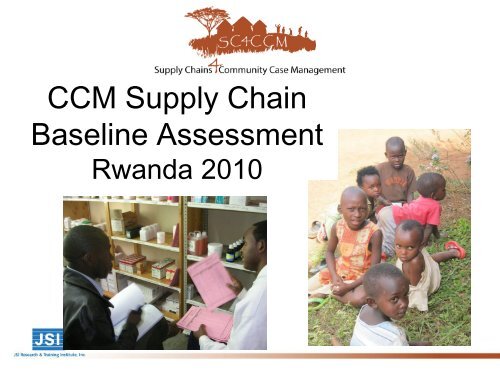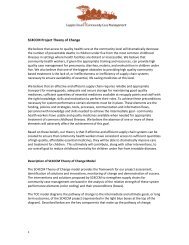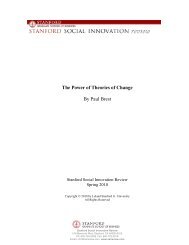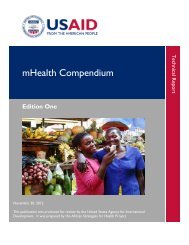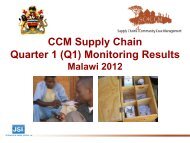CCM Supply Chain Baseline Assessment
Rwanda data validation workshop presentation - SC4CCM
Rwanda data validation workshop presentation - SC4CCM
- No tags were found...
You also want an ePaper? Increase the reach of your titles
YUMPU automatically turns print PDFs into web optimized ePapers that Google loves.
<strong>CCM</strong> <strong>Supply</strong> <strong>Chain</strong><br />
<strong>Baseline</strong> <strong>Assessment</strong><br />
Rwanda 2010
SC4<strong>CCM</strong> Project Goal<br />
SC4<strong>CCM</strong> will identify, demonstrate, and<br />
institutionalize supply chain management<br />
practices that improve the availability and<br />
use of selected essential health products<br />
in community-based programs.<br />
– In partnership with MoH, <strong>CCM</strong> and supply<br />
chain stakeholders
Principles – SC4<strong>CCM</strong><br />
Theory of Change<br />
If effective and efficient supply chain<br />
systems can be created to ensure that<br />
community health workers have consistent<br />
access to sufficient quantities of high<br />
quality, affordable essential medicines,<br />
they will be able to dramatically improve<br />
care and treatment for children.
Improving <strong>Supply</strong> <strong>Chain</strong>s for Community Case Management of<br />
Pneumonia and Other Common Diseases of Childhood (SC4<strong>CCM</strong>)<br />
Theory of Change Model<br />
F<br />
G<br />
1. Sick children receive<br />
appropriate treatment for common childhood illnesses*<br />
2. CHWs have usable and quality medicines available when<br />
needed for appropriate treatment of common childhood<br />
illnesses*<br />
Lead on activities<br />
Involved but not lead<br />
Influence through advocacy<br />
Policy / Strategy<br />
Communication /<br />
Information<br />
Funding<br />
Processes<br />
Knowledge / Skills<br />
Tools / Resources<br />
System Performance<br />
Goals and Outcomes<br />
3. Necessary, usable, quality <strong>CCM</strong> products are<br />
available at CHW resupply point/s<br />
4. CHWs, or person responsible for CHW resupply,<br />
know how, where, what, when and how much of<br />
each product to requisition or resupply and act as<br />
needed<br />
5. CHWs have adequate storage:<br />
correct conditions, security and adequate space.<br />
6. Goods are routinely transported between<br />
resupply points and CHWs<br />
7. CHWs are motivated to perform their roles<br />
in the <strong>CCM</strong> product supply chain<br />
8. Adequate<br />
quantities of <strong>CCM</strong><br />
products are<br />
available at all<br />
distribution points<br />
in country<br />
16. Timely procurement<br />
of quality <strong>CCM</strong> products<br />
occurs<br />
29. Product<br />
specifications are<br />
determined for<br />
procurement<br />
32. High-quality, childand<br />
supply chain friendly<br />
<strong>CCM</strong> products are on<br />
NEML<br />
42. Registration<br />
of new highquality,<br />
childand<br />
supply<br />
chain friendly<br />
<strong>CCM</strong> products<br />
occurs<br />
50. High-quality, child- and<br />
supply chain - friendly <strong>CCM</strong><br />
products are available from<br />
global, regional, or local<br />
marketplace<br />
9. Transport is<br />
available to<br />
distribute or collect<br />
<strong>CCM</strong> products as<br />
required to<br />
resupply points<br />
B<br />
43. <strong>CCM</strong> product<br />
selection is based<br />
on standard<br />
treatment<br />
algorithms and<br />
supply chain<br />
considerations<br />
10. Resupply point/<br />
s have adequate<br />
storage:<br />
correct conditions,<br />
security and<br />
adequate space<br />
17. Tools and resources needed to<br />
implement procedures are provided<br />
30. Funds are allocated<br />
for procurement based<br />
on quantification and<br />
disbursed regularly<br />
33. Funding and<br />
procurement<br />
cycles are<br />
aligned<br />
51. Sufficient funding for<br />
procuring commodities are<br />
available<br />
11. Staff at all resupply<br />
points are motivated<br />
and perform their roles<br />
in the <strong>CCM</strong> product<br />
supply chain as<br />
expected<br />
34. Mechanism for<br />
communication<br />
between<br />
stakeholders exists<br />
44. Visibility of<br />
program, supply<br />
and demand data<br />
exists<br />
31. Routine<br />
quantification for<br />
procurement is done<br />
52. Streamlined procedures<br />
for routine quantification<br />
and pipeline monitoring<br />
exist and are documented<br />
18. CHWs<br />
routinely<br />
collect and<br />
report timely,<br />
accurate<br />
logistics data<br />
45. Staff<br />
responsible for<br />
quantification are<br />
trained<br />
35. Staff at resupply<br />
point/s are trained in<br />
procedures and processes<br />
for <strong>CCM</strong> product supply<br />
chain<br />
12. Tools and<br />
resources needed<br />
to implement<br />
procedures are<br />
provided<br />
19. LMIS forms or<br />
other data<br />
collection tools are<br />
available for CHWs<br />
46. Streamlined procedures<br />
for ordering, reporting,<br />
inventory control, storage<br />
and disposal of expired /<br />
damaged health products<br />
exist and are documented<br />
36. CHWs are trained in<br />
procedures and<br />
processes<br />
for <strong>CCM</strong> product supply<br />
chain<br />
20. Appropriate<br />
and secure<br />
storage space<br />
for <strong>CCM</strong><br />
products is<br />
available<br />
21. Secure and<br />
suitable storage<br />
containers or<br />
shelving for <strong>CCM</strong><br />
products are<br />
procured where<br />
needed<br />
22. Transport is<br />
maintained on<br />
a regular basis<br />
for purpose of<br />
<strong>CCM</strong> product<br />
distribution<br />
37. Spare<br />
parts are<br />
available for<br />
maintenance<br />
of transport<br />
54. Government designates a budget line / or donor provides sufficient funding for<br />
program and those funds are allocated and disbursed when needed<br />
13. Reliable, timely and appropriate<br />
transport is available to distribute or collect<br />
goods between resupply point and CHWs<br />
23. Fuel<br />
procured when<br />
necessary for<br />
purpose of<br />
<strong>CCM</strong> product<br />
distribution<br />
C<br />
24. Adequate<br />
transport<br />
procured or hired<br />
when necessary<br />
for purpose of<br />
<strong>CCM</strong> product<br />
distribution<br />
38. Drivers are trained in SC<br />
transport, appropriate product<br />
handling & maintenance<br />
procedures and transportation<br />
schedule<br />
47. Streamlined transportation<br />
procedures for maintaining<br />
vehicles and distribution /<br />
collection of goods exist and<br />
are documented<br />
25. Skilled<br />
drivers are<br />
available when<br />
and where<br />
needed<br />
D<br />
14. Supportive supervision of<br />
CHWs with SC component is<br />
performed regularly<br />
39.<br />
Transportation<br />
and other<br />
resources<br />
available to<br />
conduct<br />
supervision<br />
26. Supervision<br />
tools are available<br />
40. Supervisors are<br />
trained in supportive<br />
supervision and the<br />
procedures and<br />
processes<br />
for <strong>CCM</strong> product<br />
supply chain<br />
48. Streamlined<br />
procedures for providing<br />
feedback and supervision<br />
to the CHWs exist and are<br />
documented<br />
15. Feedback is<br />
communicated<br />
to CHWs<br />
27. CHW<br />
Supervisors<br />
know of and<br />
distribute<br />
incentives when<br />
appropriate<br />
E<br />
41. Staff<br />
responsible for<br />
providing logistics<br />
feedback reports<br />
are trained and<br />
produce reports<br />
28. CHWs<br />
have<br />
knowledge<br />
of incentives<br />
49. Defined CHW<br />
incentive system<br />
that includes supply<br />
chain performance<br />
exists and is<br />
documented<br />
53. Manufacturers have<br />
information on estimated<br />
demand for acceptable<br />
formulations of <strong>CCM</strong><br />
products, including viable<br />
price points<br />
55. Strategy or Plan to achieve Commodity<br />
Security for <strong>CCM</strong> products exists<br />
1<br />
56. Unit/s exists that plan, manage and coordinate resources, services,<br />
contracts, budget, personnel etc.<br />
57. <strong>CCM</strong> Policy – MOH commitment to child survival, organizational support and structure, staffing of CHWs exists<br />
A
SC4<strong>CCM</strong> Core Indicators<br />
Derived from<br />
the main<br />
country level<br />
objective and<br />
immediate<br />
preconditions<br />
GOAL LEVEL OBJECTIVES<br />
Sick children receive appropriate treatment for common<br />
childhood illnesses<br />
Main Country Level Objective:<br />
ASCs have usable and quality medicines available when<br />
needed for appropriate treatment of common childhood<br />
illnesses<br />
Precondition 1:<br />
Necessary, usable,<br />
quality <strong>CCM</strong><br />
products are<br />
available at ASCs<br />
resupply point/s<br />
Precondition 2:<br />
ASCs, or person<br />
responsible for ASCs<br />
resupply, know how,<br />
where, what, when and<br />
how much of each<br />
product to requisition or<br />
resupply and act as<br />
needed<br />
Precondition 3:<br />
ASCs have<br />
adequate storage:<br />
correct conditions,<br />
security and<br />
adequate space.<br />
Precondition 4:<br />
Goods are routinely<br />
transported<br />
between resupply<br />
points and ASCs<br />
Precondition 5:<br />
ASCs are motivated<br />
to perform their roles<br />
in the <strong>CCM</strong> product<br />
supply chain
Methodology<br />
Both qualitative and quantitative methods were<br />
applied:<br />
• Logistics System <strong>Assessment</strong> Tool (LSAT)<br />
– 40 participants, 24 from MOH institutions/districts, 16<br />
from partner organizations<br />
• Key informant interviews<br />
• Logistics Indicators <strong>Assessment</strong> Tool (LIAT)<br />
– Mobile phones<br />
– Build local capacity partnering with local evaluation<br />
group: National University of Rwanda, School of<br />
Public Health (SPH)
LIAT Sampling<br />
Level of<br />
Administration /<br />
Facility South North Kigali East West Total<br />
District 2 2 1 3 2 10<br />
Health Center<br />
(CS) 20 22 8 30 20 100<br />
ASC<br />
(Agent de Sante<br />
Communautaire) 67 72 22 103 57 321
District Sample<br />
South North East<br />
Huye Burera Bugesera<br />
Ruhango Musanze Ngoma<br />
Kigali West Rwamagana<br />
Gasabo Nyabihu<br />
Rutsiro
Limitations<br />
• Duration of field work lengthened by:<br />
– Contact information for ASCs not complete<br />
– Health facility staff absences due to ongoing MOH<br />
trainings<br />
– Delays in administrative and financial processes<br />
– Dropout of data collectors after initial fieldwork period<br />
lapsed<br />
• Due to delays, survey conducted during rainy season (North,<br />
West):<br />
– Difficulties reaching sites<br />
• Replacements necessary because some selected sites not<br />
active in <strong>CCM</strong>
<strong>Baseline</strong> Results
Tracer Products<br />
1. Amoxicillin 250mg capsules<br />
2. Primo Rouge (ACT 1x6) tablets<br />
3. Primo Jaune (ACT 2x6) tablets<br />
4. Malaria Rapid Diagnostic Tests (RDTs)<br />
5. Zinc 20 mg tablets<br />
6. ORS sachets<br />
7. Sur’Eau bottles<br />
8. Male condoms<br />
9. Injectable contraceptive vials
Describing the ASCs Sample<br />
321 ASCs<br />
manage at least<br />
one product<br />
294 ASCs manage<br />
both Primo Jaune<br />
and Primo Rouge<br />
208 ASCs manage<br />
both Primos, ORS,<br />
zinc and amoxicillin<br />
[8 districts]<br />
112 ASCs manage<br />
both Primo, ORS,<br />
zinc, amoxicillin and<br />
RDTs [6 districts]<br />
53 ASCs manage male<br />
condoms
Main Country Level Objective:<br />
ASCs have usable and quality medicines available<br />
when needed for appropriate treatment of common<br />
childhood illnesses<br />
Key Finding: 49% of 208 ASCs who<br />
manage the 5 health products* needed to<br />
treat common childhood illnesses<br />
(pneumonia, diarrhea, and malaria) had<br />
them all in stock on the day of visit (DOV)<br />
*ORS, amoxicillin, zinc and both Primos
In Stock at ASCs on DOV<br />
195 of 294 (66%)<br />
ASCs who<br />
manage both<br />
Primos had them<br />
in stock<br />
102 of 208 (49%) ASCs who manage<br />
both Primos, ORS, amoxicillin and zinc<br />
have all in stock<br />
64 of 112 (57%) ASCs<br />
managing both<br />
Primos, ORS,<br />
amoxicillin, zinc and<br />
RDTs have them all in<br />
stock
In Stock on DOV at ASCs by Product<br />
N=321<br />
100%<br />
% instock of who manage % Who manage<br />
80%<br />
60%<br />
40%<br />
79%<br />
76%<br />
66%<br />
88%<br />
85%<br />
83%<br />
20%<br />
88%<br />
0%<br />
PrimoJ<br />
(n=302)<br />
PrimoR<br />
(n=305)<br />
Both<br />
Primos<br />
(n=294)<br />
Amoxicillin<br />
(n=238)<br />
Zinc<br />
(n=240)<br />
ORS<br />
(n=238)<br />
RDTS<br />
(n=136)<br />
48%<br />
Male<br />
condoms<br />
(n=53)
% ASCs with Five Key Drugs In Stock<br />
(Amoxicillin, ORS, Zinc & PrimoR/PrimoJ)<br />
90<br />
80<br />
70<br />
60<br />
50<br />
40<br />
30<br />
20<br />
10<br />
0<br />
Burera<br />
Rutsiro<br />
Musanze<br />
Gasabo<br />
Ruhango<br />
Nyabihu<br />
Bugesera<br />
Ngoma<br />
South North Kigali East West<br />
Total<br />
49% of 208
Average Stockout Duration and Stock Status for<br />
ASCs March-August 2010<br />
Type of Product<br />
Average duration<br />
stockouts<br />
(months)<br />
Average<br />
months of<br />
information on<br />
stock card<br />
Average<br />
months of<br />
stock*<br />
Zinc 1.6 (n=37) 2.7 (n=200) 10.9<br />
Amoxicillin 1.7 (n=28) 2.6 (n=197) 3.9<br />
ORS 1.5 (n=41) 2.6 (n=186) 5.8<br />
Primo Rouge 1.6 (n=72) 2.9 (n=185) 2.3<br />
Primo Jaune 2.0 (n=62) 2.6 (n=181) 2.1<br />
*Stockouts not included
PRECONDITION 1:<br />
Necessary, usable, quality <strong>CCM</strong> products<br />
are available at ASCs resupply point/s<br />
• Product availability at the resupply point appears<br />
to be strongly linked to product availability at the<br />
ASCs Level for:<br />
• Zinc<br />
• Amoxicillin<br />
• ASCs considerably overstocked in amoxicillin,<br />
zinc and ORS
Product Availability at All Levels on<br />
DOV<br />
Availability<br />
of both<br />
Primos<br />
District<br />
80% had both Primos<br />
CS<br />
84% of 96 who manage<br />
both<br />
had both Primos<br />
District<br />
70% had ORS,<br />
Amoxicillin, Zinc &<br />
both Primos<br />
CS<br />
64% of 85 who manage had<br />
ORS, Amoxicillin, Zinc &<br />
both Primos<br />
Availability<br />
of ORS,<br />
Amoxicillin,<br />
Zinc and<br />
both<br />
Primos<br />
ASCs<br />
66% of 294 who<br />
manage both<br />
had both Primos<br />
ASCs<br />
49% of 208 who manage<br />
ORS, Amoxicillin, Zinc &<br />
both Primos
% of Resupply Points and ASCs in<br />
100%<br />
Stock on DOV<br />
80%<br />
Instock DoV<br />
60%<br />
40%<br />
20%<br />
0%<br />
PrimoR<br />
(n=97;<br />
305)<br />
PrimoJ<br />
(n=96,<br />
302)<br />
ORS<br />
(n=98;<br />
238)<br />
Zinc<br />
(n=95;<br />
240)<br />
Amoxicillin<br />
(n=87;<br />
238)<br />
RDT<br />
(n=80;<br />
136)<br />
Male<br />
condoms<br />
(n=84; 53)<br />
Resupply<br />
ASCB
Stock Status (up to 6 mos.) at<br />
all levels, based on Min/Max<br />
concept<br />
Months of stock<br />
10.0<br />
9.0<br />
8.0<br />
7.0<br />
6.0<br />
5.0<br />
4.0<br />
3.0<br />
2.0<br />
1.0<br />
0.0<br />
Amoxicillin PrimoR PrimoJ Zinc ORS RDT<br />
CS<br />
District<br />
ASCB<br />
Colored bars represent ideal Min Max ranges for CS and District
3. Necessary, usable, quality <strong>CCM</strong><br />
products are available at CHW<br />
resupply point/s<br />
8. Adequate quantities of <strong>CCM</strong><br />
products are available at all<br />
distribution points in country<br />
Frequent stockouts at<br />
central level and therefore<br />
at DPs, especially of Primo<br />
Rouge<br />
LSAT<br />
Results<br />
Precondition 1<br />
16. Timely procurement<br />
of quality <strong>CCM</strong> products<br />
occurs<br />
“No central level<br />
procurement plan“<br />
“No coordination<br />
among partners and<br />
programs“<br />
“DPs quantify without<br />
receiving or using ASC<br />
consumption reports or<br />
quantities required”<br />
30. Funds are allocated for<br />
procurement based on<br />
quantification and disbursed<br />
regularly<br />
33. Funding and<br />
procurement<br />
cycles are aligned<br />
34. Mechanism for<br />
communication<br />
between<br />
stakeholders exists<br />
44. Visibility of<br />
program, supply<br />
and demand data<br />
exists<br />
31. Routine<br />
quantification for<br />
procurement is done<br />
45. Staff responsible<br />
for quantification<br />
are trained<br />
52. Streamlined procedures for routine<br />
quantification and pipeline monitoring exist<br />
and are documented<br />
“Sufficient funding for<br />
commodities“<br />
Lack of<br />
understanding of the<br />
national<br />
quantification<br />
process outside<br />
CAMERWA
PRECONDITION 2:<br />
ASCs, or person responsible for ASCs resupply, know<br />
how, where, what, when and how much of each<br />
product to requisition or resupply and act as needed<br />
• High levels of supply chain training reported by<br />
staff at CS and ASCs<br />
• <strong>Supply</strong> chain data not visible at all levels of the<br />
system<br />
• No standard operating procedures (SOPs) or<br />
standard formula of resupply quantities for ASCs
Pharmacy<br />
Task Force<br />
CAMERWA<br />
MOH Programs<br />
BUFMAR<br />
22%<br />
100% 78%<br />
44%<br />
10%<br />
Flow of<br />
Products<br />
DISTRICT<br />
HOSPITALS<br />
8%<br />
DISTRICT<br />
text<br />
PHARMACIES<br />
80% Collect / 20% Delivery<br />
1%<br />
and<br />
22%<br />
3%<br />
100% 94%<br />
Information<br />
OTHER HEALTH<br />
CENTERS<br />
1%<br />
HEALTH<br />
CENTERS<br />
text<br />
86% collect / 11% delivery / 3%<br />
depends<br />
SECTEUR<br />
Key<br />
Flow of commodities<br />
Flow of information<br />
Flow of finance<br />
97%<br />
text<br />
54%<br />
2%<br />
57%<br />
2.5%<br />
CELLULE<br />
ASCB<br />
text<br />
99.4% collect<br />
4%<br />
Umudugudu
ASCs Reported Training<br />
in <strong>Supply</strong> <strong>Chain</strong> Management<br />
ASCs formally<br />
trained in SC<br />
areas<br />
(N=304)<br />
% ASCs who reported training in all three: record<br />
keeping, ordering, receiving (combined as a %)<br />
% ASCs who reported training in both: storage<br />
and FEFO (combined as a %)<br />
% ASCs who reported training in transportation<br />
49%<br />
93%<br />
79%
Methods used by ASCs to<br />
Determine Resupply Quantity<br />
35%<br />
30%<br />
25%<br />
20%<br />
No standard<br />
method for<br />
calculating<br />
resupply quantities<br />
for ASCs<br />
15%<br />
10%<br />
5%<br />
0%<br />
do not know<br />
someone else<br />
decides how<br />
much to supply<br />
based on forms<br />
submitted<br />
Others<br />
whenever the<br />
"last container"<br />
is opened<br />
same as last<br />
month
Availability of Stock Card at ASC Level<br />
100%<br />
80%<br />
72% of ASCs<br />
report using a<br />
stock card<br />
But stock card<br />
use varies by<br />
product<br />
60%<br />
40%<br />
61% 60%<br />
83% 83%<br />
78%<br />
20%<br />
28%<br />
0%<br />
PrimoR<br />
(n=305)<br />
PrimoJ<br />
(n=302)<br />
Zinc<br />
(n=240)<br />
Amox<br />
(n=238)<br />
ORS<br />
(n=238)<br />
RDT<br />
(n=136)<br />
Manages but no stock card for product<br />
Has stock card
Types of Reports Submitted<br />
ASCBs<br />
96%<br />
9%<br />
1%<br />
Reporting mostly<br />
standardized for<br />
ASCs, but CS<br />
appears to have high<br />
reporting burden<br />
Health Centre<br />
80%<br />
20%<br />
39%<br />
27%<br />
District<br />
22%<br />
22%<br />
33%<br />
Requisition form<br />
Others<br />
Electronic requisition form<br />
Monthly activity report<br />
Electronic HMIS report<br />
Other standard report
Completion of ASC Monthly Report<br />
% of Information Included and Completed on ASCs Reporting Forms<br />
Viewed at the ASC Level (n=248)<br />
100%<br />
80%<br />
88%<br />
88%<br />
Key supply chain<br />
data included and<br />
completed on<br />
majority of reports<br />
60%<br />
86%<br />
86%<br />
83%<br />
82%<br />
40%<br />
20%<br />
36%<br />
36%<br />
0%<br />
Stock on hand<br />
Quantities<br />
dispensed<br />
11%<br />
Losses Adjustments None<br />
11%<br />
Included<br />
Completed
“Not all products<br />
are included on<br />
LMIS forms “<br />
4. CHWs, or person responsible for CHW<br />
resupply, know how, where, what, when<br />
and how much of each product to<br />
requisition or resupply and act as needed<br />
18. CHWs routinely<br />
collect and report<br />
timely, accurate<br />
logistics data<br />
12. Tools and resources<br />
needed to implement<br />
procedures are<br />
provided<br />
“No documents<br />
that collect<br />
consumption<br />
data at ASC,<br />
requisition<br />
documents exist<br />
only for Primo“<br />
“LMIS forms need<br />
to be harmonized “<br />
19. LMIS forms or<br />
other data<br />
collection tools are<br />
available for CHWs<br />
“This is a resupply<br />
and reporting<br />
system without a<br />
reporting tool”<br />
LSAT<br />
Results<br />
Precondition 2<br />
36. CHWs are trained in<br />
procedures and processes<br />
for <strong>CCM</strong> product supply<br />
chain<br />
46. Streamlined procedures for<br />
ordering, reporting, inventory control,<br />
storage and disposal of expired /<br />
damaged health products exist and<br />
are documented
PRECONDITION 3:<br />
ASCs have adequate storage: correct<br />
conditions, security and adequate space.<br />
Standards for appropriate storage conditions<br />
appear generally well maintained at all<br />
levels, with some outstanding gaps, and<br />
some conflicting evidence from qualitative<br />
results
Satisfactory Storage Conditions<br />
Health products are stored:<br />
1. in an area free of rodents or insects<br />
2. securely with a lock and key, and with limited access<br />
3. in an area that is protected from direct sunlight<br />
4. at the appropriate temperature<br />
5. in a clean, dry, well-lit and well-ventilated storeroom<br />
6. in an area that is accessible during all normal working<br />
hours.<br />
7. so that first-to-expire, first-out (FEFO) is observed<br />
8. on shelves or stacked off the floor in stacks and away<br />
from walls<br />
9. separately to damaged and/or expired health products<br />
10. well organized in the drug box (ASCs only)
Storage gaps: Two conditions require<br />
improvement at all levels<br />
60%<br />
50%<br />
50%<br />
Districts CS ASC<br />
40%<br />
30%<br />
20%<br />
27%<br />
16%<br />
10%<br />
23%<br />
24%<br />
10%<br />
0%<br />
Insufficient area<br />
Expired stock not removed<br />
The current storeroom or<br />
storage area or box and<br />
organization are not<br />
sufficient for existing<br />
medicines and supplies<br />
The stock card did not indicate<br />
removal of any damaged or<br />
expired medicines or supplies<br />
that are on site on the day of the<br />
visit
Storage gaps: Conditions requiring<br />
improvement at each level<br />
District<br />
CS<br />
Do not store products on shelves or stacked off the floor 30% 13%<br />
Do not store products organized by FEFO 20% 16%<br />
Do no store products away from direct sun 10%<br />
Do not store them separately from chemicals and<br />
insecticides<br />
10%<br />
Do not secure the storage box with a lock and key, nor is access limited to<br />
authorized personnel<br />
37%<br />
Do not store products in a clean, dry, well-lit and well-ventilated storage area 15%<br />
Storage area or box is NOT free of rodents or insects 15%<br />
ASC
5. CHWs have adequate storage:<br />
correct conditions, security and adequate space.<br />
LSAT Results<br />
Precondition 3<br />
“Storage capacity<br />
not adequate<br />
…products stored<br />
near goats,<br />
cookers,<br />
bedrooms”<br />
20. Appropriate<br />
and secure<br />
storage space<br />
for <strong>CCM</strong><br />
products is<br />
available<br />
21. Secure and<br />
suitable storage<br />
containers or<br />
shelving for <strong>CCM</strong><br />
products are<br />
procured where<br />
needed<br />
“Secure boxes are<br />
old, in poor<br />
condition and can’t<br />
be replaced due to<br />
lack of funds”
PRECONDITION 4:<br />
Goods are routinely transported<br />
between resupply points and ASCs<br />
• ASCs are generally located in remote areas that<br />
are difficult to reach particularly during rainy season<br />
• 26% of 90 ASCs with problems related to collecting<br />
or receiving health products reported lack of<br />
transport as the major constraint
Problems Collecting/Receiving Products<br />
Reported by 90 out of 321 ASCs<br />
75%<br />
50%<br />
Most ASCs travel less<br />
than an hour in dry<br />
season, while about half<br />
must travel more than an<br />
hour in rainy season<br />
n=320 Dry Rainy<br />
25%<br />
Most ASCs travel by foot, and the<br />
roads are overwhelmingly dirt.<br />
Transport and Distance<br />
88% of ASCs travel by foot, 10%<br />
use bikes, 0.9% use private<br />
vehicles, and 0.3% use public<br />
transport.<br />
On foot<br />
34 min by car<br />
Bike<br />
38 min by car<br />
0 10 20 30 40 50 60 70 80 90 100<br />
% ASCs who manage products using this type of transport<br />
Other All dirt, bad condition All dirt, good condition<br />
Less than half tarmac More than half tarmac All tarmac<br />
*Length of bar indicates the distance an ASCs would have to travel to get to health center by car (in minutes).<br />
*Segments of bar indicate the proportion of ASCs using this type of transport who travel on various types of roads.<br />
*Line length indicates the percent of ASCs that use this type of transport.<br />
%
LSAT Results<br />
Precondition 4<br />
6. Goods are routinely transported<br />
between<br />
resupply points and CHWs<br />
13. Reliable, timely and appropriate<br />
transport is available to distribute or collect<br />
goods between resupply point and CHWs<br />
“Distribution schedules exist<br />
for all levels but orders not<br />
delivered/collected on<br />
schedule.”<br />
“Transportation not used<br />
efficiently since there are<br />
too many uses for one<br />
vehicle.”<br />
24. Adequate transport procured or<br />
hired when necessary for purpose<br />
of <strong>CCM</strong> product distribution<br />
47. Streamlined transportation<br />
procedures for maintaining vehicles and<br />
distribution /collection of goods exist and<br />
are documented<br />
“Transportation is<br />
insufficient at all<br />
levels.”
PRECONDITION 5:<br />
ASCs are motivated to perform their roles in<br />
the <strong>CCM</strong> product supply chain<br />
• Biggest motivators for ASCs<br />
– Social relationships, trust and esteem from<br />
neighbours (47%)<br />
– Being able to save children’s lives/help<br />
community (27%)<br />
• 90% ASCs reported being supervised at<br />
least once a quarter (54% monthly, 36%<br />
quarterly)
What motivates ASCs to do their<br />
job?<br />
Motivating factors for ASCs<br />
Wages<br />
Being a humanitarian<br />
Enjoys the job<br />
Elected by community members<br />
Acquiring skills and self-confidences<br />
Impact on population’ health<br />
Happy to be a volunteer<br />
Serving the community<br />
Self-fulfillment from saving children's lives<br />
Improving relationships, trust with neighbors<br />
0 5 10 15 20 25 30 35 40 45 50<br />
% n=321
Supervision<br />
87% supervisors reported<br />
providing supervision to ASCs<br />
every 3 months<br />
• 96% supervisors reported<br />
providing feedback<br />
Last 3 months<br />
93% ASCs reported receiving<br />
a supervisory visit in last 3<br />
months<br />
•82% ASCs reported receiving<br />
feedback specifically on<br />
managing products<br />
…supervisors report<br />
supervising an average of<br />
88 ASCs each<br />
ASC<br />
ASC<br />
ASC<br />
Does most supervision<br />
visits occur in a group<br />
setting?<br />
Supervisor<br />
Are drug boxes viewed<br />
during supervision?<br />
ASC<br />
ASC<br />
ASC
9%<br />
23%<br />
318 ASCs Report Charging a<br />
Fee to Clients<br />
Services only<br />
Services and<br />
products<br />
It depends<br />
Some ASCs charge<br />
for consultation only.<br />
Variation in amount of<br />
fees charged: Huye &<br />
Rwamagana are the<br />
only districts<br />
charging 0-100 Frw<br />
68%<br />
45%<br />
40%<br />
35%<br />
30%<br />
25%<br />
20%<br />
18%<br />
29%<br />
12%<br />
40%<br />
15%<br />
10%<br />
5%<br />
0%<br />
0-100 Frw 101-200 Frw 201- 300 Frw It depends<br />
Value of fees charged by ASCs
Access to Communication Technology<br />
98% of ASCs who manage health<br />
products have a mobile phone<br />
62% have network<br />
coverage at work all<br />
the time,<br />
85% have at least<br />
sometimes<br />
39% have source<br />
of recharge for<br />
phone battery<br />
9% have at least<br />
sometimes
LSAT Results<br />
Precondition 5<br />
“Supervision<br />
done<br />
sporadically,<br />
not according<br />
to schedule.”<br />
14. Supportive supervision<br />
of CHWs with SC component<br />
is performed regularly<br />
26. Supervision<br />
tools are<br />
available<br />
7. CHWs are motivated to perform their<br />
roles<br />
in the <strong>CCM</strong> product supply chain<br />
15. Feedback is<br />
communicated<br />
to CHWs<br />
27. CHW<br />
Supervisors know<br />
of and distribute<br />
incentives when<br />
appropriate<br />
“ASCs not<br />
motivated…they don’t<br />
earn anything, not<br />
compensated for time<br />
they spend on<br />
community activities”<br />
28. CHWs have<br />
knowledge of<br />
incentives<br />
39. Transportation<br />
and other resources<br />
available to conduct<br />
supervision<br />
40. Supervisors are trained<br />
in supportive supervision<br />
and the procedures and<br />
processes<br />
for <strong>CCM</strong> product supply<br />
chain<br />
41. Staff responsible<br />
for providing logistics<br />
feedback reports are<br />
trained and produce<br />
reports<br />
“Funds for<br />
supervision<br />
insufficient.”<br />
48. Streamlined procedures for<br />
providing feedback and<br />
supervision to the CHWs exist<br />
and are documented<br />
49. Defined CHW incentive<br />
system that includes supply<br />
chain performance exists and is<br />
documented
General results: <strong>CCM</strong> <strong>Supply</strong><br />
<strong>Chain</strong> & Customer Service<br />
• Barriers to client accessing ASC services:<br />
– Between Aug-Nov 2010, 38 ASCs reported<br />
referring patients because of a stockout<br />
– Frequent stockouts affect client confidence in<br />
system → are not consistently served (*LSAT)<br />
– Clients pay Fr200 for ASC service, if referred<br />
have to pay another Fr200 (*LSAT)
General results: ASCs’ Greatest<br />
Challenge in Managing Health Products<br />
Resupply point<br />
3%<br />
Other<br />
18%<br />
Remuneration<br />
40%<br />
What would you<br />
consider your greatest<br />
challenge to managing<br />
health products?<br />
Workload<br />
8%<br />
Storage<br />
11%<br />
Transport<br />
27%<br />
N=320
Thank You


